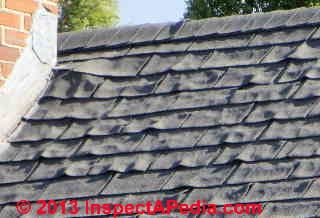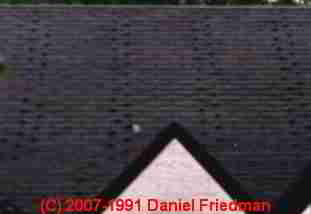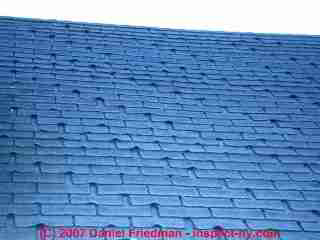 Fishmouth Curling on Asphalt Shingle Roofs
Fishmouth Curling on Asphalt Shingle Roofs
- POST a QUESTION or COMMENT about roof shingle fish mouthing & curling
Shingle fishmouthing:
This asphalt shingle roofing wear & damage article tells explains and illustrates how to identify & explain the asphalt shingle roof wear pattern known as "fishmouthing" or "fishmouthed roof shingles". We discuss the cause of fishmouth patterns in roof shingles and its effect on remaining roof life.
We also sort out confusion among home inspectors using the terms shingle curling, shingle fish-mouth openings, & shingle laddering patterns.
By listing common causes of asphalt roof shingle failures and how to recognize them, building owners and roofing contractors may also be able to reduce the occurrence of asphalt roof shingle storage, handling, and installation errors that affect roof life. Readers are also invited contribute roof failure information to the web author for research purposes. web author for research purposes.
InspectAPedia tolerates no conflicts of interest. We have no relationship with advertisers, products, or services discussed at this website.
- Daniel Friedman, Publisher/Editor/Author - See WHO ARE WE?
Fishmouthing Asphalt Shingle Explanation & Photos

At left and below we illustrate the asphalt shingle fishmouth failure pattern. Any cupping, curling, or fish-mouthing on roof shingles is an indicator of wear and age, but importantly it also means that the roof is fragile.
Photo above: fishmouthed shingles in a ladder pattern on a roof argue for the role of shingle butt joints in the appearance of fishmouthing.
[Click to enlarge any image]
Photo at left: fishmouthed shingles occurring in a pattern mapping shingle laddering (explained below). [Click to enlarge any image or photo.]
Watch out: walking on curled, cupped, or fish-mouthed shingles risks breaking them, converting a possible leak (wind-blown rain) into a probable need for roof replacement.
When understanding fishmouthing on roof shingles we want to know its cause, how we evaluate fishmouthing as a sign of roof wear and other problems, and how to prevent this condition.
We contrast the shingle fishmouth failure pattern with shingle curling failure patterns.
These defects occur on both organic-mat or fiberglass-mat asphalt roof shingles but in my [DF] OPINION, it is more common in organic shingles.
Causes of Asphalt Shingle Fishmouth Patterns & Wear
McNulty, criticizing organic felt-based roofing shingles argues that insufficient asphalt saturation causes fishmouthing failures on roofing.
The disadvantage to organic felts is moisture related. Inadequate saturation and exposure to moisture can result in curling and fishmouthing as a result of dimensional changes as the shingle absorbs and releases moisture. Even an adequately saturated felt can, under certain conditions, exhibit the same problems.
The problems outlined above can be minimized by
1) ensuring proper saturation of the felt and
2) the application of heavier coatings on both sides of the felt (to provide greater moisture protection and guard against cold curl) to help the shingle to lie flat. (McNulty 2000)
Really? If saturation alone were the principal basis of fishmouthing failures on roofs then we would expect to see this pattern appear uniformly over the roof surface. In nearly 40 years of inspecting roofs I have never found this to be the case. Not once. And Davis (1977) found fishmouthing on both organic and fiberglass-based asphalt roof shingles. Bailey (1994) reported this failure pattern on modified bitumen roofs, most likely a different phenomenon.
In my opinion, while saturation of felts may be a factor and while I agree that fishmouthing appears on organic shingles, the fundamental cause of shingles that curl in a characteristic fish-mouth pattern (the curled shingle reminds some of an open fish's mouth, gasping for air) is most likely differential expansion and shrinkage across the shingle thickness, perhaps combined with loss of volatiles from the substrate of organic shingles.
Photo above: fishmouthed shingles appearing mostly in a ladder pattern on the roof (except near the chimney).
Most roof experts agree that fish-mouthed shingles indicate a combination of roof moisture and a roof ventilation defects. Since that shingle failure mechanism is not unique to the fish-mouth curling pattern, it is interesting and perhaps diagnostic to understand why shingles curl in the fish-mouth pattern in particular. To understand fishmouthing let's notice
- Where in the shingle body the characteristic fishmouth "curl" appears
- Where on the whole roof the fishmouthed shingles appear
- Building or site moisture or other conditions that may be factors in fishmouthing of roof shingles
The distribution of fish-mouthed shingle curling itself very often occurs in a pattern on the roof, mapping something - what? Almost invariably you will see that the fishmouth curl occurs over a butt-joint between two adjacent shingles. That is, the curl itself occurs not at the corner of a shingle tab (that's conventional "shingle curling) but rather in or near the middle of the shingle tab.
But the fish mouth does not occur on every shingle tab, just those that overlie a butt-joint of shingles below. This does not always happen, but it usually does.

The location of fishmouths on roof shingles is predictable and diagnostic: if inspected closely the shingles will show that this pattern of raised open lower shingle edges will occur first and worst over the shingle butt joints where individual shingle sides abut one another.
In the photo at left the shingles were mostly installed in a staggered or stair step pattern when they were installed! Compare this pattern with the "straight up the roof" shingle laddering photographs shown above.
So the pattern of "fishmouths" on the roof may be regular, following a diagonal or a ladder pattern depending on how the shingles were nailed on the roof.
In the fishmouthed shingle photo just above-left you can see that shingles were staggered during installation on the roof, not laddered.
Inadequate Venting and High Building Moisture Cause of Asphalt Shingle Fishmouthing
Fishmouthed cupping of asphalt roof shingles is caused by excessive under-roof moisture such as by a poorly or un-vented attic or roof cavity. Moisture escaping through the roof sheathing and up through the bottom of the shingles contacts the uppermost shingle which spans the butt joint of shingles below, placing more moisture at that point on the shingle tab than elsewhere. This uneven moisture, probably combined with weather exposure, leads to a raised, cupped "fishmouth" look on those shingles.
Shingles are not quite waterproof: You may not realize it but asphalt roof shingles are not quite waterproof and in particular the back side of asphalt shingles is much less water resistant than the upper or exposed side. The exposed side of an asphalt shingle is protected from sun damage by a coating of mineral granules. These shingles rely on the pitch of the roof and mechanical drainage combined with proper placement or pattern of shingling on the roof to avoid leaks. [This photo courtesy of Carl Gerosa, New Rochelle, NY.]
Sources of Moisture Contributing to Fish-Mouthing Shingles
Common shingle failure factors include improper storage and handling of the asphalt shingles before installation, improper nailing, improper flashing (which pertains to any roofing material), and defective asphalt shingle product material leading to thermal splitting, cracking, blistering, staining, and in some cases curling or cupping shingles.
An example of the less-than-fully-waterproof back of asphalt roof shingles is seen in our photos of "fishmouthed" roof shingles. In these cases a specific "curling" pattern of shingles called "fishmouthing" displays a raised shingle edge which looks a lot like a fish's open mouth. These shingles are not curled over at the very edge.
Shingle Fishmouthing is a Building Diagnostic Aid
Digging deeper into the building moisture question that might begin by observing fish-mouthed shingles we might ask why is there high moisture under the shingles: leaks? inadequate roof venting, a wet basement, some other moisture source.
Photo at left: shingle fishmouthing in a ladder pattern over a car wash.
I took this photograph of fish mouthed roof shingles as a great example of how they diagnose other building conditions. This was a car wash - talk about a lot of interior moisture in a building! There was also no roof venting system of any consequence on the building.
So fishmouthed roof shingles mean that there has been a combination of high interior building moisture, (maybe from a wet basement or a flood?) combined with poor or inadequate under-roof ventilation.
Unlike other more normal wear patterns on asphalt roofs, such as curling, cupping, or even some cracking or granule loss patterns, fishmouthing tells us something more about the building itself and its leak, moisture, and venting history and design.
In sum, curled roof shingles might lead us to a wet basement or some other unusual building moisture source that also needs attention.
Fishmouthed Asphalt Roof Shingles under light snow cover - an Ice Dam, Leak, Mold, Rot Warnings
Because the raised "fishmouths" on asphalt shingles show up above and through a light snow cover, this is one roof pattern, wear indicator, and sign of both moisture and bad roof venting design that you might be able to diagnose from the ground under some conditions.
This is an important condition to notice because the same inadequate under-roof venting that was a factor in the creation of these fishmouths on the roof surface may also have led to ice dam problems on the same building. In turn, ice dams may have led to leaks into attics, ceilings, or building walls.
In turn, leaks into building walls might have led to a hidden mold problem on the building. So those fishmouthed shingles might actually be a fair predictor of mold problems on some buildings and if other factors or complaints are present, might be a reason to explore the building wall cavities under the roof eaves, looking for evidence of leaks, mold, rot, or insect damage where otherwise we might not feel that such invasive measures were justified.
Fishmouthed Asphalt Shingles are Vulnerable to Damage
As we suggested in the cased of other cupped, curled, or fragile asphalt roof surfaces, we would stay off of fishmouthed-shingle roofs, particularly in cold weather (when the fishmouthed roof shingles are more likely to break). If we have to walk on a fishmouthed shingle roof, tiptoe carefully, avoiding stepping on the raised or fishmouthed shingle sections.
Do Fishmouthed Asphalt Shingles Need Replacement?
If the shingles are not damaged, broken, cracked, or showing other signs of wear, it may be possible to leave these shingles on the roof longer than otherwise. That's because this fishmouth pattern can show up earlier in shingle life on a wet building with poor under-roof venting. An experienced inspector or roofer can point out the extent of roof damage and other shingle wear signs that will decide if the roof is ready to be replaced.
Fishmouthing Shingle Research
- Also see additional citations atReferences or Citations at the end of this and other InspectApedia roofing articles.
- Akbari, Hashem, Ronnen Levinson, and Paul Berdahl. "A Review of Methods for the Manufacture of Residential Roofing Surfaces." Dated Jun (2003).
- Bailey, David M., W. J. Rossiter, and J. F. Seiler. "Three Modified Bitumen Roofing Membranes at Fort Polk: Preliminary Field Test Results." ASTM SPECIAL TECHNICAL PUBLICATION 1224 (1994): 45-45.
- Davis, Duane A., and R. Allan Snyder. "Cold process roofing: system performance with fiber glass and felt base membranes." In Proceedings of 3 rd International Symposium on Roofing Technology, pp. 215-223. 1977.
- Johnson, James H., and Paul C. Bresnahan. Guidelines for Quality Assurance Inspection of Commercial Activities Contracts for Real Property Maintenance Activities. Guide Number 7: Building Services. No. CERL-SR-FF-94/07. CONSTRUCTION ENGINEERING RESEARCH LAB (ARMY) CHAMPAIGN IL, 1993.
- McNulty, Raymond A. "Asphalt Roof Shingles - Composition, Performance, Function, and Standards." [PDF] Interface (2000). - retrieved 2015/12/03, original source: http://www.rci-online.org/interface/2000-01-mcnulty.pdf
Abstract:
This paper describes the composition and function of each of the layers of a shingle. The various types of shingles and their application are discussed. The more common problems associated with asphalt shingles and the probable causes for these problems are reviewed. The various standards pertaining to asphalt shingles are also discussed. - Shuman, E. C. "Moisture-Thermal Effects Produce Erratic Motions in Built-up Roofing." Engineering Properties of Roofing Systems, ASTM STP 409 (1967): 41.
...
Continue reading at ROOF VENTILATION SPECIFICATIONS or select a topic from the closely-related articles below, or see the complete ARTICLE INDEX.
Or see these
Recommended Articles
Suggested citation for this web page
FISHMOUTHING ASPHALT SHINGLES at InspectApedia.com - online encyclopedia of building & environmental inspection, testing, diagnosis, repair, & problem prevention advice.
Or see this
INDEX to RELATED ARTICLES: ARTICLE INDEX to BUILDING ROOFING
Or use the SEARCH BOX found below to Ask a Question or Search InspectApedia
Ask a Question or Search InspectApedia
Try the search box just below, or if you prefer, post a question or comment in the Comments box below and we will respond promptly.
Search the InspectApedia website
Note: appearance of your Comment below may be delayed: if your comment contains an image, photograph, web link, or text that looks to the software as if it might be a web link, your posting will appear after it has been approved by a moderator. Apologies for the delay.
Only one image can be added per comment but you can post as many comments, and therefore images, as you like.
You will not receive a notification when a response to your question has been posted.
Please bookmark this page to make it easy for you to check back for our response.
IF above you see "Comment Form is loading comments..." then COMMENT BOX - countable.ca / bawkbox.com IS NOT WORKING.
In any case you are welcome to send an email directly to us at InspectApedia.com at editor@inspectApedia.com
We'll reply to you directly. Please help us help you by noting, in your email, the URL of the InspectApedia page where you wanted to comment.
Citations & References
In addition to any citations in the article above, a full list is available on request.
- Thanks to reader Louis Tolley, Adams WI , for discussing fishmouthed roof shingles, early failure of a new roof, and for photographs of fishmouthed roof shingles - July 2010
- Our recommended books about building & mechanical systems design, inspection, problem diagnosis, and repair, and about indoor environment and IAQ testing, diagnosis, and cleanup are at the InspectAPedia Bookstore. Also see our Book Reviews - InspectAPedia.
- Asphalt Roofing Residential Manual from ARMA the Asphalt Roofing Manufacturers Association Website https://www.asphaltroofing.org/product/residential-asphalt-roofing-manual/ ,
- Problems in Roofing Design, B. Harrison McCampbell, Butterworth Heineman, 1991 ISBN 0-7506-9162-X (available used)
- Roofing The Right Way, Steven Bolt, McGraw-Hill Professional; 3rd Ed (1996), ISBN-10: 0070066507, ISBN-13: 978-0070066502
- In addition to citations & references found in this article, see the research citations given at the end of the related articles found at our suggested
CONTINUE READING or RECOMMENDED ARTICLES.
- Carson, Dunlop & Associates Ltd., 120 Carlton Street Suite 407, Toronto ON M5A 4K2. Tel: (416) 964-9415 1-800-268-7070 Email: info@carsondunlop.com. Alan Carson is a past president of ASHI, the American Society of Home Inspectors.
Thanks to Alan Carson and Bob Dunlop, for permission for InspectAPedia to use text excerpts from The HOME REFERENCE BOOK - the Encyclopedia of Homes and to use illustrations from The ILLUSTRATED HOME .
Carson Dunlop Associates provides extensive home inspection education and report writing material. In gratitude we provide links to tsome Carson Dunlop Associates products and services.




